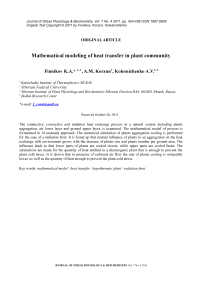Моделирование теплопередачи в сообществе растений
Автор: Финников К.А., Корзун А.М., Колесниченко А.В.
Журнал: Журнал стресс-физиологии и биохимии @jspb
Статья в выпуске: 4 т.7, 2011 года.
Бесплатный доступ
Рассмотрен процесс кондуктивного, конвективного и радиационного теплообмена в модели природной системы, включающей сообщество растений, приземный слой воздуха и верхний слой грунта. В одномерном нестационарном приближении сформулирована математическая модель процесса. Проведено численное моделирование процесса охлаждения растений в сообществе в условиях радиационного заморозка. Выяснено, что взаимное влияние растений в сообществе на теплообмен с окружающей средой, усиливающееся по мере увеличения размеров растений и их количества на единицу площади поверхности грунта, приводит к замедлению остывания в нижней части растений и ускорению остывания в верхней части. Проведены оценки количества выделяемого в термогенном растении тепла, достаточного для защиты растения от холодового стресса. Показано, что при наличии вынужденного движения воздуха скорость остывания растений существенно снижается, как и энергозатраты термогенного растения на защиту от холодового стресса.
Короткий адрес: https://sciup.org/14323570
IDR: 14323570
Текст научной статьи Моделирование теплопередачи в сообществе растений
Обозначения: C – объемная теплоемкость; d – диаметр растений; h – высота растений; n – количество растений на единице площади грунта; T – температура; t – время; z – вертикальная координата; λ – теплопроводность
Индексы: air – воздух; g – грунт; pl – растения; sky – отдаленные воздушные массы
В настоящее время растения разделеляются на две группы: термогенные (способные к интенсивному термогенезу, в частности, ароидные ( Araceae ) (Knutson 1974, Meeuse, 1975), саговниковые ( Cycadaceae ) и анноновые ( Annonaceae ) (Gottsberger, 1990), кувшинковые ( Nymphaeaceae ) (Prance, Arias 1975), кирказоновые ( Aristolochiaceae ) (Raskin et al., 1987), пальмы ( Arecaceae ) и циклантовые ( Cyclanthaceae ) (Gottsberger, 1990; Listabarth,
1996), магнолиевые ( Magnoliaceae ) (Thien et al., 1999), лотосовые ( Nelumbonaceae ) (Schneider, Buchanan 1980) и рафлезиевые ( Rafflesiaceae ) (Patino et al., 2000) и нетермогенные (не обладающие такой способностью).
Относительно физиологической роли термогенеза у термогенных растений, большинство исследователей в настоящее время считает, что данное явление является адаптивной особенностью для перекрестного опыления.
Однако имеются данные и о наличии этого явления в стрессовых условиях у нетермогенных растений. В ряде статей (Vojnikov et al., 1984, Ordentlich et al., 1991, Nevo et al., 1992, Moynihan et al., 1995, Kolesnichenko et al., 2003) была выдвинута гипотеза о терморегуляторной роли этого феномена у растений при гипотермии.
Гипотеза о физиологическом значении термогенеза была подвергнута критике в работе Breidenbach с соавт. (1997), теоретические расчеты которых показали, что дыхательные пути не имеют значительной разницы в энтальпии, и что наблюдаемое повышение уровня тепла у нетермогенных растений, характеризуемых удельной мощностью тепловыделения ~ 1 Вт/дм3, является недостаточным для физиологически значимого повышения температуры тканей или органелл. В то же время анализ теплообмена в продуктивных органах термогенных растений и окружающей среде, проведенные авторами, показали возможность достижения существенного перепада температуры между поверхностью растения и воздухом при характерной для термогенных растений удельной мощности тепловыделения ~50 Вт/дм3. Аналогичные данные были получены и при анализе необходимой мощности тепловыделения у проростков при низкотемпературном стрессе, проведенном ранее (Finnikov et al, 2010). Было показано, что для растения с характерным диаметром стебля ~2 мм удельная мощность тепловыделения должна составлять от 50 до 100 Вт/кг. В то же время все эти расчеты проводились для случая одиночного растения, в то время как и в дикой природе, и на культурных полях растения существуют в основном в виде сплошного ковра, влияя друг на друга.
В связи с этим, представляет интерес изучение вопрос о мощности источника тепла, необходимого для защиты растений от замерзания прежде всего в случае наличия редкого травостоя — 25 — 100 растений на квадратный метр.
Случай сообщества растений отличается от рассматривавшегося ранее случая одиночного растения наличием взаимного влияния процессов теплообмена отдельных растений с окружающей средой. В частности:
Растения поглощают излучение, испущенное с поверхности других растений;
Растения влияют на поле температуры и скорости окружающей среды.
Наиболее простой моделью, позволяющей привести качественный анализ отмеченных факторов, является одномерная модель, в которой все параметры считаются зависимыми только от расстояния от поверхности грунта, которое далее будем обозначать как z . Поверхность грунта соответствует началу координат. Переменными модели являются:
при z < 0 – температура грунта T g ( z )
при z > 0 – температура воздуха T air ( z ) и температура растений T pl ( z ).
Математическая модель образуется уравнениями переноса тепла в трех средах: в грунте, в воздухе и в растительной массе.
Перенос тепла в грунте описывается уравнением теплопроводности без источника
Cp
d Tg
^^^^^^
/
d t
— X
d z
\
d Tg ) g d z /
= 0
d T pt d z
Уравнение определено на интервале от некоторого отрицательного значения z до 0. Нижняя граница интервала должна соответствовать достаточно большой глубине, чтобы в течение расчетного времени в ее окрестности сохранялось распределение температуры, близкое к начальному однородному распределению. При этом на данной границе может быть установлено как условие 1 рода – температура, равная начальной, так и условие 2 рода – отсутствие потока тепла. В данном исследовании выбран второй вариант. На верхней границе – поверхности грунта ставится условие заданного потока тепла, образуемого теплопроводностью воздуха, растительной массы и радиационным потоком:

Перенос тепла в растительной массе описывается уравнение теплопроводности с двумя источниковыми слагаемыми
d TDl f d TD^
Cpl^f- "Г X = R + W + 5, (2) 01 0 z 0 z
\
Уравнение определено на интервале от 0 до h . Граничное условие на границе z = 0 – заданное значение температуры, равное температуре поверхности грунта:
T Pl\z = 0 = Tg\ z = 0 .
Граничное условие на границе z = h – отсутствие потока тепла:
Теплообмен растений с воздухом моделируется при помощи источникового слагаемого в уравнении (2), записываемого как
W ( z ) = 2 « dn ( Tpl ( z ) - T air ( z ) ) « .
Здесь а - коэффициент теплообмена, оцениваемый с помощью критериальных соотношений для теплообмена между цилиндром и поперечно обтекающим его потоком среды (Цветков, 2009):
Nu = I d = G,58Re0,471 Pr0,33
X air где Re и Pr – числа Рейнольдса и Прандтля, определяемые по скорости ветра и теплофизическим параметрам воздуха. В отсутствие ветра рассматривался чисто кондуктивный механизм теплоотдачи, для которого число Нуссельта оценивается как
Слагаемое S в правой части (2) описывает внутренний источник тепла в растении, определяемый в конкретной постановке задачи.
Слагаемое R в правой части (2) описывает радиационный теплообмен растений друг с другом, с грунтом и с отдаленными воздушными слоями. При выводе данного слагаемого будем исходить из предполагаемой геометрии сообщества растений – случайным образом распределенные на плоскости цилиндры с вертикальной осью. В качестве промежуточного результата необходимо вывести выражение для доли излучения, испущенного с поверхности растения, которая пройдет без поглощения расстояние A z вдоль вертикальной координаты. Для луча, направленного под углом в к вертикали, вероятность пройти без поглощения расстояние A z вдоль вертикальной координаты равна exP(- ndA z tg в ). Искомая доля излучения находится путем усреднения данной вероятности по направлениям испускаемого излучения, учитывая, что излучение испускается с боковой поверхности цилиндра, нормаль к которой ориентирована горизонтально:
-
2 п /2
M(Az) = — [ sin2 в exp(- ndAztgв )de (3) п 0
Данное выражение, в частности, дает M (0) = 1 / 2 , что соответствует тому, что половина испускаемого излучения идет вверх, а половина – вниз. В бесконечном пределе аргумента M ^ 0 , что описывает затухание излучения на больших расстояниях.
В соответствии с определением функции M, доля излучения, испущенного с поверхности растения в точке z0 и поглощенного между точками Z и z + dz, при dz > 0 , определяется как dM
dz dM(z0 - z) „
------------dz, z< z, dz *
С использованием данных соотношений запишем поток излучения, поступающий на данный участок поверхности растения со стороны окружающих растений:
/(z)=«Jj1^Miy*(c ^X
dM^Vz) W^ di;
Рассматривая грунт и отдаленные воздушные слои как полубесконечные области с постоянной температурой, получим выражение для разности поглощаемой и излучаемой мощности в единице объема – источника в уравнении (2):

Плотность потока энергии, поступающего на поверхность грунта от растений и отдаленных воздушных слоев, рассчитывается как

Отметим, что второе слагаемое в выражении для qr ad , соответствующее радиационному теплообмену между грунтом и отдаленными воздушными слоями, удовлетворяет условию ослабевания данного канала теплообмена при увеличении высоты растений: множитель ( h . . 'I
-
1 - 2 n nd^ M ( Z ) d Z
I 0 J убывает с ростом h или nd и стремится к нулю в бесконечном пределе этих параметров.
Перенос тепла в воздухе описывается уравнением теплопроводности с источником, описывающим теплообмен с растениями. Источник в данном уравнении, очевидно, противоположен соответствующему источнику в уравнении (2) и уравнение переноса тепла имеет следующий вид:
C air ^TOir -4( X air ^T Oi^ '=- W . (6)
01 0 z ^ 0 z ^
Уравнение определено на интервале от 0 до некоторого H>h, величина которого выбирается исходя из того, чтобы в течение расчетного времени возмущение температуры не достигло данной координаты. В рамках настоящего исследования принято H=2 м.
Граничное условие на границе z = 0 – заданное значение температуры, равное температуре поверхности грунта:
T aiAz _ 0 = T g\z _ 0 .
Граничное условие на границе z = H – отсутствие потока тепла:
-
u T air _ 0
-
d z z = H
Дискретный аналог уравнений (1, 2, 6) строится с помощью конечно-объемного метода (Патанкар, 1984) на разностной сетке с постоянным шагом. Аппроксимация пространственных производных температур на границах ячеек выполняется при помощи центрально-разностной схемы. Аппроксимация временных производных проводится с использованиемнеявнойсхемыпервогопорядка точности. Источниковые слагаемые в (2, 6) учитываютсяявнымобразом.
Совместное решение уравнений реализуется путем последовательного расчета значений температур на новом временном слое: расчет температуры грунта, далее – температуры растенийи,наконец,температурывоздуха.При расчетеновыхзначенийтемпературыгрунтапо уравнению (1) используется значение потока тепла на поверхность грунта, взятое с предыдущего временного слоя. При расчете температур воздуха и растений используется новыезначениятемпературынанижнейгранице области, равной температуре поверхности грунта.
РЕЗУЛЬТАТЫ МОДЕЛИРОВАНИЯ
Степень влияния соседних растений – как близких, так и отдаленных, на теплообмен данного конкретного растенияс окружающей средой зависит от нескольких параметров рассматриваемой задачи, главными из которых являютсяразмерырастенийиихколичествона единице площади поверхности грунта. Предварительные результаты, полученные с использованием вышеописанной модели для растений с небольшими размерами –высота около20мм,диаметроколо2ммпоказали,что такие растения обмениваются теплом практическинезависимодруготдруга,покаих количество наединицуплощадинепревысит порядка 1000 растений на м2, что является чрезмерно большой величиной для типичных сельскохозяйственных культур. Взаимное влияние должно начать проявляться у более взрослых растений, характеризующихся б о льшими значениямивысотыидиаметра. В настоящем исследовании выбраны величины: диаметр–5мм,высота–20см.
С целью рассмотрения данного вопроса проведены расчеты для нескольких вариантов, отличающихся величиной n – количества растенийнаединицуплощади.Впределемалых n растенияневлияютдругнадруга; помере увеличенияnрастетвлияниевсегосообщества растений на теплообмен отдельного растения с окружающей средой. Температура отдаленных воздушных слоев принят равной –8°С, что соответствует величине радиационного теплового потока, уходящего с горизонтальной поверхности при температуре 5°С, равной 60 Вт/м2. В качестве начальных условий принято однородное поле температуры, равной 5°С.
В первой серии расчетов моделировался процесс без внутренних источников тепла в растении. В четырех вариантах расчета количество растений на единицу площади принималось равным: 1) малой величиной, при которой растения можно считать одиночными; 2) 25 растений на м2; 3) 50 растений на м2; 4) 100 растений на м2.
Результаты первой серии расчетов представлены на рисунках 1 (распределение температуры растительной массы) и 2 (распределение температуры воздуха). По прошествии 2 часов с момента начала заморозка температура в одиночном растении принимает значения от □ 0°С вблизи поверхности грунта до □ – 2°С на остальной протяженности стебля; к верхнему концу стебля температура незначительно повышается, что связано с тем, что данная часть растения контактирует с более теплым, чем вблизи грунта, воздухом. В сообществе растений, даже при сравнительно небольшой плотности растений на поверхности грунта, существенны эффекты радиационного переноса тепла. Радиационный перенос формирует поток энергии, идущий от грунта к растительной массе (преимущественно к ее нижележащим слоям), от нижележащих слоев растительной массы – к вышележащим, и от растительной массы (преимущественно от ее вышележащих слоев) – к отдаленным воздушным слоям. В результате растительная масса принимает температуру, плавно снижающуюся по вертикальной координате. По ходу кривых на рис. 1 однозначно видно, что увеличение количества растений на единицу площади приводит к повышению температуры нижней части растений и, одновременно, к более быстрому падению температуры по высоте.
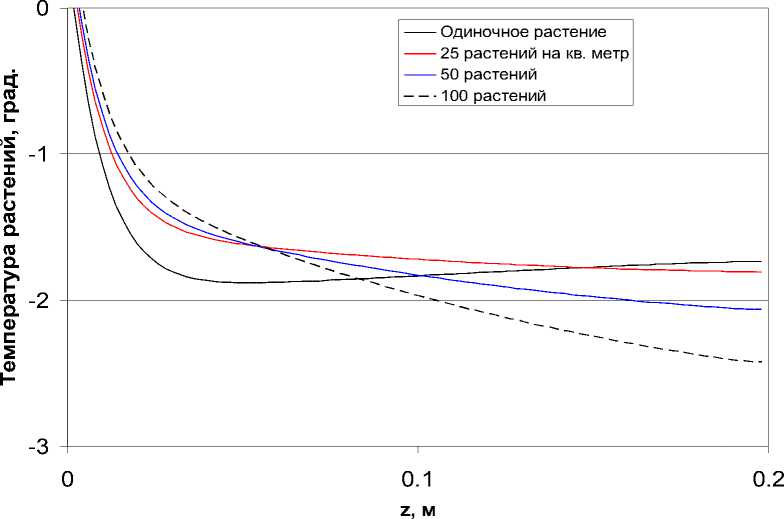
Рисунок 1: Распределение температуры растений по вертикали, 1 расчетная серия
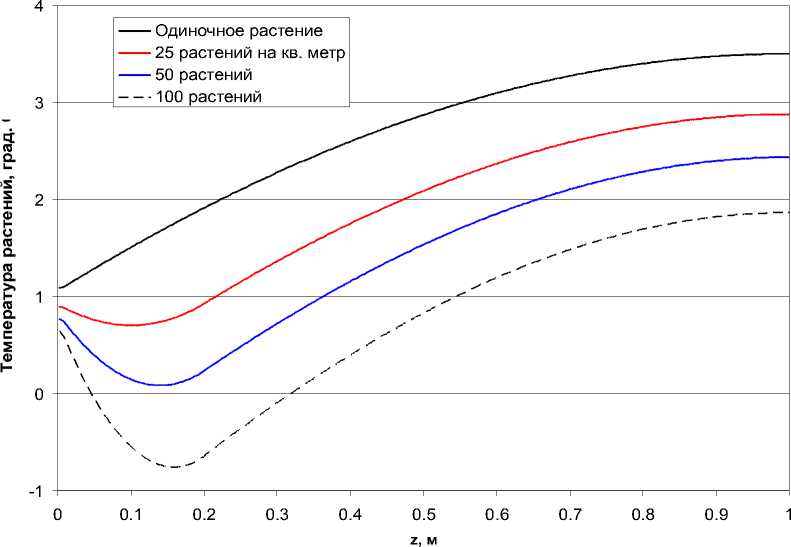
Рисунок 2: Распределение температуры воздуха по высоте, 1 расчетная серия
Эти эффекты являются следствием того, что сообщество растений поглощает тепловое излучение, затрудняя радиационный теплообмен в системе «грунт – растения – отдаленные воздушные слои».
Влияние сообщества растений на температуру окружающего воздуха можно оценить по результатам, приведенным на рис. 2. Кривая для одиночного растения практически соответствует случаю отсутствия влияния растений. В данном случае наблюдается монотонная растущая зависимость температуры от высоты, обусловленная наличием радиационного стока тепла в точке z = 0. При наличии растительной массы часть радиационного стока тепла оказывается распределенной в надземном пространстве, вследствие чего сообщество растений и воздух, находящийся с ней в тепловом контакте, остывают быстрее, чем поверхность грунта. Данный эффект усиливается по мере роста количества растений на единицу площади.
Вторая расчетная серия проведена для случая наличия внутреннего источника тепла в растении. С целью определения энергетических затрат растения на поддержание положительной температуры был принят следующий подход к заданию источника тепла. Считается, что источник имеет мощность, минимально необходимую для поддержания положительной температуры; таким образом, он отсутствует в областях растения, имеющих положительную температуру. Учет влияния источника проводится следующим образом. После выполнения расчета очередного временного шага температура растения корректируется на величину A T , определяемую как
A T(z) = - min( T(z) ,0).
Интегральное энерговыделение внутри растения рассчитывается суммированием порций коррекциям температуры:
энергии, соответствующим проделанным о (z )= Cpi I A T (z).
Таблица 1. Усредненное по объему растения удельное энерговыделение. Вторая серия расчетов.
|
Количество растений на м2 |
Среднее энерговыделение, кДж/кг |
|
Одиночное растение |
38 |
|
25 |
32 |
|
50 |
32 |
|
100 |
31 |
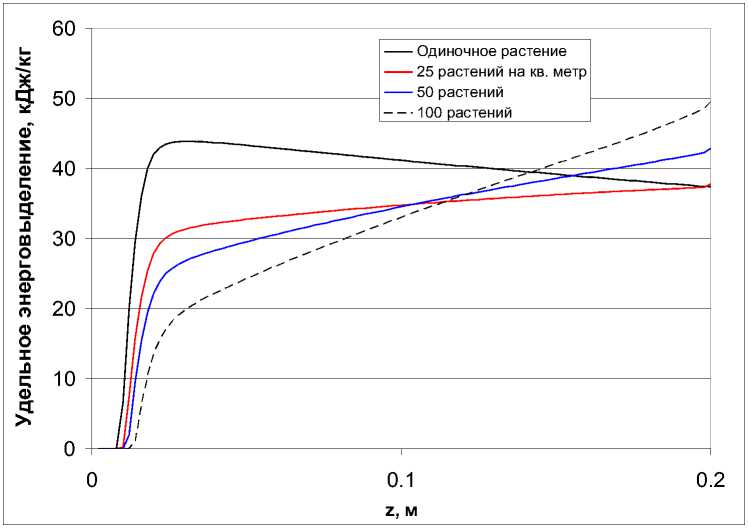
Рисунок 3: Интегральное энерговыделение в растительной массе, 2 расчетная серия
Распределение интегрального энерговыделения по высоте внутри растения представлено на рис. 3. Форма распределения при различных количествах растений на единицу площади находится в соответствии с формой распределения температуры в отсутствие энерговыделения (рис. 1). Те участки растений, которые наиболее сильно охлаждаются в отсутствие энерговыделения, требуют наибольших энергозатрат для поддержания положительной температуры. В Таблице 1 приведены величины среднего по объему растения энерговыделения. Как можно видеть, взаимное влияние растений на теплообмен между ними и окружающей средой не слишком существенно снижает необходимые энергозатраты на поддержание положительной температуры растения. Благодаря этому влиянию, наиболее существенным эффектом которого является поглощение испускаемого теплового излучения, происходит только перераспределение энергозатрат: нижние области растений теряют тепло медленнее, тогда как верхние – быстрее.
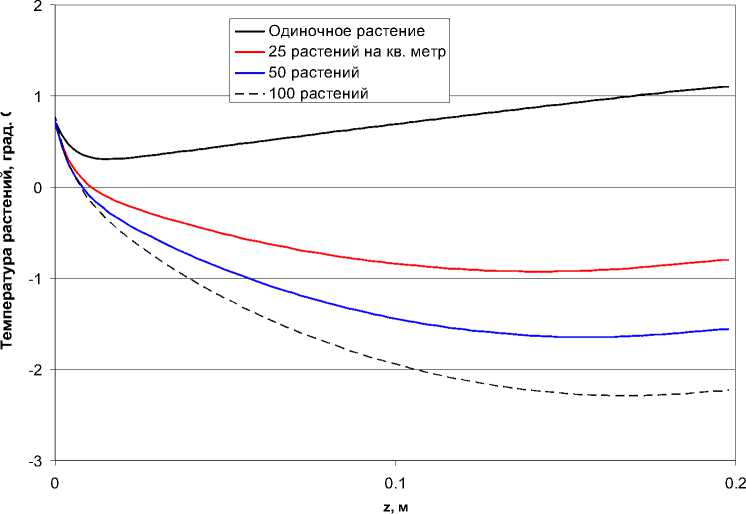
Рисунок 4: Распределение температуры растений по вертикали, 3 расчетная серия
Влияние вынужденного движения воздуха на теплообмен в сообществе растений и окружающей среде
Предварительные расчеты показали, что при принятых размерах растений вынужденноконвективная теплопередача между растением и воздухом становится существенной при скорости ветра порядка 0,02 м/с, что соответствует числу рейнольдса Re~10 (определяется по диаметру растения). При этом качественное изменение наблюдаемой картины происходит при скорости ветра от 0,1 м/с. При данном значении скорости проведена третья серия расчетов. Результаты расчетов приведены на рис. 4, 5. Наличие ветра интенсифицировало теплообмен растений с воздухом. Вследствие этого температура растений стала выше, чем в отсутствие ветра, а температура воздуха – напротив, ниже. Для одиночного растения температура не достигает нуля ни в одной точке. Во всех вариантах температура растения достигает минимума не в верхней точке, а несколько ниже него. Отличие этой картины от наблюдавшейся в 1-й серии является следствием возросшего влияния теплообмена растения с воздухом, поскольку температура воздуха на уровне верхней части растения начинает расти по высоте.
Четвертая серия расчетов проведена для случая с внутренним источником тепла, рассматриваемым тем же образом, что во второй серии. Все прочие условия аналогичны третьей серии расчетов. Распределение интегрального энерговыделения по высоте растения приведено на рис. 6. Как и для второй серии расчетов, здесь наблюдается соответствие между температурой растения в отсутствие энерговыделения и мощностью энерговыделения, необходимой для поддержания положительного уровня температуры. Значения усредненного по объему растения удельного энерговыделения приведены в Таблице 2. Приведенные значения существенно меньше, чем во второй расчетной серии, что вполне согласуется с другими наблюдаемыми следствиями наличия движения воздуха. Таким образом, в условиях радиационного заморозка наличие ветра является фактором, снижающим интенсивность холодового стресса.
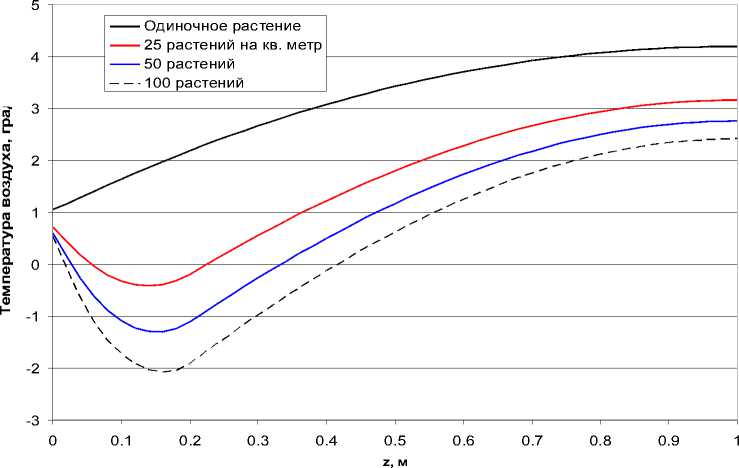
Рисунок 5: Распределение температуры воздуха по высоте, 3 расчетная серия

Рисунок 6: Интегральное энерговыделение в растительной массе, 4 расчетная серия
Таблица 2 Усредненное по объему растения удельное энерговыделение. Четвертая серия расчетов.
|
Количество растений на м2 |
Среднее энерговыделение, кДж/кг |
|
Одиночное растение |
0 |
|
25 |
11 |
|
50 |
22 |
|
100 |
28 |
Численный анализ теплообмена между сообществом растений и окружающей средой, проведенный в одномерном нестационарном приближении, позволил качественно рассмотреть эффекты взаимовлияния растений внутри сообщества на теплообмен с окружающей средой. Характер процесса охлаждения сообщества растений во время радиационного заморозка в общих чертах аналогичен процессу охлаждения одиночного растения. Растение теряет тепло за счет испускания излучения и получает его за счет кондуктивно-конвективного теплообмена с воздухом и радиационного теплообмена с грунтом. Наименьшие значения температуры наблюдаются в верхушках растений. Наличие соседствующих растений вносит в эту картину отдельные поправки. Основными следствиями наличия сообщества растений являются коллективное охлаждение растениями прилегающего воздуха и поглощение теплового излучения. В ходе радиационного заморозка в результате поглощения и переизлучения тепла формируется поток энергии, направленный от грунта к нижним частям растений, от нижних частей растения – к верхним, и, далее, в окружающее воздушное пространство. В связи с этим увеличение количества растений на единицу площади, приводящее к усилению поглощения излучения, увеличивает градиент температуры растительной массы по высоте. Уже при сравнительно небольшом количестве растений на единицу площади заметным становится их влияние на температуру воздуха, которая начинает не расти с высотой, а падать, что также приводит к росту градиента температуры растения по высоте.
Проведены оценки количества тепла, которое должно быть выделено в термогенном растении для обеспечения защиты от холодового стресса.
В оптимальном случае источники тепла, обеспечивающие защиту растения, должны быть расположены в основном в верхней части растения, наиболее сильно подверженной охлаждению. Влияние наличия сообщества растений на энергозатраты, требуемые для защиты от холодового стресса, не является однозначным. С одной стороны, увеличение количества растений приводит к усилению охлаждения воздуха и к более быстрому исчерпанию его запасов тепла, а следовательно – к увеличению требуемого количества тепла. С другой стороны, поглощение теплового излучения снижает удельные тепловые потери сообщества и уменьшает недостачу тепла. Если в отсутствие вынужденного движения воздуха наблюдалось небольшое снижение средних удельных энергозатрат с ростом количества растений, то при наличии ветра, при котором теплообмен растений с воздухом более интенсивен, средние удельные энергозатраты растут. Существенно иная картина может наблюдаться при других размерах растений, что должно быть предметом дальнейших исследований.
Работа выполнена при поддержке гранта Конкурса интеграционных проектов СО РАН, №45 (2009-2011г.г.).
Цветков Ф.Ф. Тепломассообмен М.: МЭИ, 2009. 550 с.
Патанкар С. Численные методы решения задач теплообмена и динамики жидкости М.: Энергоатомиздат, 1984. 345 с.
Breidenbach RW, Saxton MJ, Hansen LD, Criddle RS (1997) Heat generation and dissipation in plants: Can the alternative oxidative phosphorylation pathway serve a thermoregulatory role in plant tissues other than specialized organs? Plant Physiol 114: 1137-1140
Finnikov K.A., Minakov A.V., Dekterev A.A., Gavrilov1 A.A., Korzun A.M., Voinikov V.K., Kolesnichenko A.V. (2010) Mathematical modeling of heat transfer between the plant seedling and the environment during a radiation frost. Journal of Stress Physiology & Biochemistry , 6(4) 108-125
Gottsberger G. (1990) Flowers and beetles in the South American Tropics Bot. Acta, . 103 : 360–365.
Knutson R. M. (1974) Heat production and temperature regulation in eastern skunk cabbage Science , 186 : 746–747.
Kolesnichenko A.V., Pobezhimova T.P., Grabelnych O.I., Tourchaninova V.V., Korzun A.M., Koroleva N.A., Zykova V.V., Voinikov V.K. (2003) Difference between the temperature of non-hardened and hardened winter wheat seedling shoots during cold stress J. Thermal Biology . 28 : 235–244.
Listabarth C. (1996) Pollination of Bactris by Phyllotrox and Epurea . Implications of the palm breeding beetles on pollination at the community level Biotropica . 28 : 69–81.
Meeuse BJD (1975) Thermogenic respiration in aroids. Annu Rev Plant Physiol 26 : 117-126
Moynihan MR, Ordentlich A, Raskin I (1995) Chilling-induced heat evolution in plants.
Plant Physiol 108 : 995-999
Nevo E, Ordentlich, Belies A, Raskin I (1992) Genetic divergence of heat production within and between the wild progenitors ofи wheat and barley: evolutionary and agronomical implications. Theor Appl Gen 84 : 958-962
Ordentlich A., Linzer R., Raskin I. (1991) Alternative respiration and heat evolution in plants Plant Physiol. . 97 . 1545-1550.
Patino S., Grace J., Banziger H. (2000) Endothermy by flowers of Rhizanthes lowii ( Rafflesiaceae ) Oecologia . 124 : 149–155.
Prance G.T., Arias J.R. (1975) A study of the floral biology of Victoria amazonica (Poepp.) Sowerby (Nymphaeaceae) Acta Amazonica . 5 : 109–139.
Raskin I., Ehmann A., Melander W.R., Meeuse B.J.D. (1987) Salicylic acid: a natural inducer of heat production in Arum lilies Science . 237 : 1601–1602.
Schneider E.L., Buchanan J.D. (1980) Morphological studies of the Nymphaeaceae. XI. The floral biology of Nelumbo pentapetala Am. J. Bot . 67 : 182–193.
Thien L.B., Azuma H., Kawano S. (1999) New perspectives in the pollination biology of basal angiosperms In: XVI International Botanical Congress .
Vojnikov V., Korzun A., Pobezhimova T., Varakina N. (1984) Effect cold shock on the mitochondrial activity and on the temperature of winter wheat seedlings Biochim. Physiol. Pflanz. 179 : 327-330.
Список литературы Моделирование теплопередачи в сообществе растений
- Цветков Ф.Ф. Тепломассообмен М.: МЭИ, 2009. 550 с.
- Патанкар С. Численные методы решения задач теплообмена и динамики жидкости М.: Энергоатомиздат, 1984. 345 с.
- Breidenbach RW, Saxton MJ, Hansen LD, Criddle RS (1997) Heat generation and dissipation in plants: Can the alternative oxidative phosphorylation pathway serve a thermoregulatory role in plant tissues other than specialized organs? Plant Physiol 114: 1137-1140
- Finnikov K.A., Minakov A.V., Dekterev A.A., Gavrilov1 A.A., Korzun A.M., Voinikov V.K., Kolesnichenko A.V. (2010) Mathematical modeling of heat transfer between the plant seedling and the environment during a radiation frost. Journal of Stress Physiology & Biochemistry, 6(4)108-125
- Gottsberger G. (1990) Flowers and beetles in the South American Tropics Bot. Acta,. 103: 360-365.
- Knutson R. M. (1974) Heat production and temperature regulation in eastern skunk cabbage Science, 186: 746-747.
- Kolesnichenko A.V., Pobezhimova T.P., Grabelnych O.I., Tourchaninova V.V., Korzun A.M., Koroleva N.A., Zykova V.V., Voinikov V.K. (2003) Difference between the temperature of non-hardened and hardened winter wheat seedling shoots during cold stress J. Thermal Biology. 28: 235-244.
- Listabarth C. (1996) Pollination of Bactris Phyllotrox Epurea. Implications of the palm breeding beetles on pollination at the community level Biotropica. 28: 69-81.
- Meeuse BJD (1975) Thermogenic respiration in aroids. Annu Rev Plant Physiol 26: 117-126
- Moynihan MR, Ordentlich A, Raskin I (1995) Chilling-induced heat evolution in plants. Plant Physiol 108: 995-999
- Nevo E, Ordentlich, Belies A, Raskin I (1992) Genetic divergence of heat production within and between the wild progenitors ofи wheat and barley: evolutionary and agronomical implications. Theor Appl Gen 84: 958-962
- Ordentlich A., Linzer R., Raskin I. () respiration and heat evolution in plants Plant Physiol.. 97. 1545-1550.
- Patino S., Grace J., Banziger H. (2000) Endothermy by flowers of Rhizanthes lowii (Rafflesiaceae) Oecologia. 124: 149-155.
- Prance G.T., Arias J.R. (1975) A study of the floral biology of Victoria amazonica (Poepp.) Sowerby (Nymphaeaceae) Acta Amazonica. 5: 109-139.
- Raskin I., Ehmann A., Melander W.R., Meeuse B.J.D. (1987) Salicylic acid: a natural inducer of heat production in Arum Science. 237: 1601-1602.
- Schneider E.L., Buchanan J.D. (1980) Morphological studies of the Nymphaeaceae. XI. The floral biology of Nelumbo pentapetala Am. J. Bot. 67: 182-193.
- Thien L.B., Azuma H., Kawano S. (1999) New perspectives in the pollination biology of basal angiosperms In: XVI International Botanical Congress.
- Vojnikov V., Korzun A., Pobezhimova T., Varakina N. (1984) Effect cold shock on the mitochondrial activity and on the temperature of winter wheat seedlings Biochim. Physiol. Pflanz. 179: 327-330.

